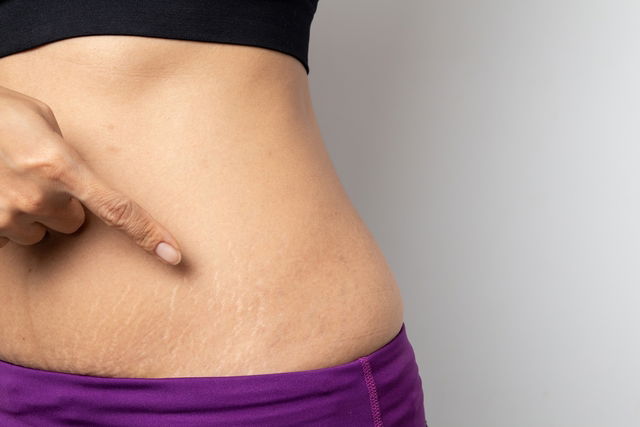To get rid of stretch marks and prevent new ones from appearing, it is possible to utilize home treatments like exfoliation or cosmetic procedures like microneedling or radiofrequency to reduce their appearance. Cosmetic procedures should be done by a dermatologist or licensed esthetician.
Treatment may depend on the color of the stretch mark, which can vary from red to white. Red or pinkish stretch marks will have greater local inflammation and will be in an earlier phases of scarring, making radiofrequency a great option. White stretch marks can be treated with microneedling, for example, which boosts and reduced circulation in the area.
Stretch marks emerge when there is a change in skin elasticity due to torn collagen fibers. These fibers are responsible for keeping the skin firm and supported. The most commonly affected area is the abdomen, however stretch marks can also appear on the breasts, armpits, glutes and thighs.

Stretch mark treatments
Some treatment options available to get rid of red and/or white stretch marks are:
1. Stretch mark cream
Stretch mark creams may be prescribed by a dermatologist to prevent stretch marks or to reduce their severity. They typically have moisturizing and healing properties that help regenerate the skin, improving the appearance and texture of stretch marks.
These creams may contain hyaluronic acid or retinoids, for example, and should be applied across the entire stretch mark in circular movements, until completely absorbed. Retinoids should not be used during pregnancy.
It is important that the treatment is guided by a dermatologist, who can determine the best product and duration for treatment.
Also recommended: Red Stretch Marks: 7 Options to Reduce & Prevent tuasaude.com/en/red-stretch-marks2. Moisturizing oils
Moisturizing oils, such as avocado oil, rosehip oil or passion fruit oil, increase skin hydration and elasticity and stimulate cell renewal and new cell growth. They can improve the appearance of new stretch marks.
Read more about the benefits of rosehip oil and how to use it.
3. Radiofrequency
Radiofrequency is a technique that promotes oxygenation, nutrition and dilation of local blood vessels. This can help to eliminate red stretch marks.
This treatment is performed by a dermatologist or a qualified professional in a cosmetic clinic.
4. Vacuum therapy
Vacuum therapy is performed using a suction on the skin, which redirects the blood into the area. This can improve circulation in areas with red stretch marks and promote their elimination.
5. Chemical peels
Chemical peels with retinoic acid or glycolic acid are performed by a dermatologist to increase collagen production, improve skin vascularization and circulation. All of these factors can help to get rid of white stretch marks.
6. Carboxytherapy
Carboxytherapy is a treatment performed by injecting carbon dioxide (CO2) directly under skin with stretch marks. It can be used to get rid of white or red stretch marks.
This treatment is carried out by a dermatologist to promote increased blood circulation and oxygenation of the skin. It works by promoting the synthesis of collagenase, elastin and hyaluronic acid, increasing skin elasticity and reducing the width of stretch marks.
7. Microneedling
Microneedling, also known as a dermaroller, stimulates the production of new collagen fibers, giving the skin greater support.
This treatment is carried out by a dermatologist using very fine microneedles.
8. Microdermabrasion
Microdermabrasion is a type of mechanical exfoliation in which the most superficial layers of the skin are removed, leaving areas of the skin with stretch marks more uniform.
This treatment is performed by a dermatologist using aluminum oxide crystals that cause an inflammatory reaction in the area, reducing the appearance stretch marks.
9. Intense pulsed light
Intense pulsed light (IPL) may be recommended by a dermatologist for the treatment of new, red stretch marks. It stimulates fibroblasts to produce collagen fibers and reorganize them in the skin.
This treatment reduces the number of red stretch marks and reduces their size and width.
10. Galvanotherapy
Galvanotherapy is carried out by a dermatologist using a galvanic current device that, through electrical stimuli, ensures the deeper penetration of certain chemical substances. This can promote the formation of collagen and elastin and improve the appearance of stretch marks.
11. Intradermotherapy
Intradermotherapy, also known as mesotherapy, is carried out by a dermatologist and involves the application of various chemical substances through injections along the entire length of the stretch marks. These injections can improve the appearance of stretch marks and reduce their size.
12. Platelet-rich plasma
Platelet-rich plasma (PRP) is a concentrated solution of blood plasma, taken from the person and filtered in the laboratory. Is is then injected into the stretch marks by a dermatologist to stimulate collagen production.
PRP can be administered alone or in combination with other treatments, such as carboxytherapy.
How to prevent new stretch marks
To prevent new stretch marks, you should ensure your skin is always moisturized, avoid rapid weight gain and weight loss patterns (which will eventually compromise skin integrity), and maintain a protein-rich diet with plenty of water.
Stretch marks commonly appear during pregnancy around the abdomen and breasts. It is essential to keep your skin moisturized from the start of your pregnancy. Before trying any specific treatment, you should consult a dermatologist.
What causes stretch marks
Stretch marks can appear in men or women at any age, however they are most common during puberty and pregnancy, as these periods are characterized by hormonal and weight changes. Stretch marks usually appear when there is an increase in skin tension, leading to damage in the collagen and elastin fibers that cause flaccidity.
